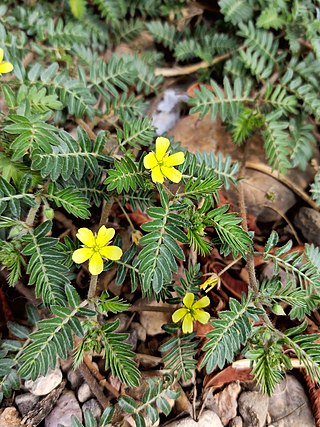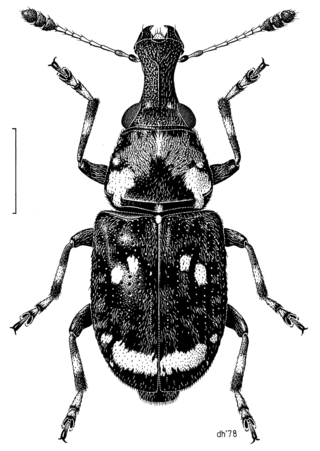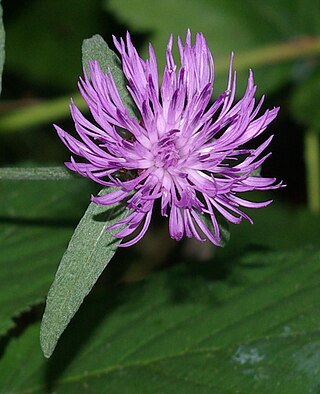
The common sunflower is a large annual forb of the genus Helianthus. It is commonly grown as a crop for its edible oily seeds. Apart from cooking oil production, it is also used as livestock forage, as bird food, in some industrial applications, and as an ornamental in domestic gardens. Wild H. annuus is a widely branched annual plant with many flower heads. The domestic sunflower, however, often possesses only a single large inflorescence atop an unbranched stem.

The sunflower seed is the seed of the sunflower. There are three types of commonly used sunflower seeds: linoleic, high oleic, and sunflower oil seeds. Each variety has its own unique levels of monounsaturated, saturated, and polyunsaturated fats. The information in this article refers mainly to the linoleic variety.

Helianthus is a genus comprising about 70 species of annual and perennial flowering plants in the daisy family Asteraceae commonly known as sunflowers. Except for three South American species, the species of Helianthus are native to North America and Central America. The best-known species is the common sunflower. This and other species, notably Jerusalem artichoke, are cultivated in temperate regions and some tropical regions, as food crops for humans, cattle, and poultry, and as ornamental plants. The species H. annuus typically grows during the summer and into early fall, with the peak growth season being mid-summer.

The bean weevils or seed beetles are a subfamily (Bruchinae) of beetles, now placed in the family Chrysomelidae, though they have historically been treated as a separate family. They are granivores, and typically infest various kinds of seeds or beans, living most of their lives inside a single seed. The subfamily includes about 1,650 species and are found worldwide.

Tribulus terrestris is an annual plant in the caltrop family (Zygophyllaceae) widely distributed around the world. It is adapted to thrive in dry climate locations in which few other plants can survive.

Centaurea solstitialis, the yellow star-thistle, is a species of thorny plant in the genus Centaurea, which is part of the family Asteraceae. A winter annual, it is native to the Mediterranean Basin region and invasive in many other places. It is also known as golden starthistle, yellow cockspur and St. Barnaby's thistle.

Chamaerops is a genus of flowering plants in the family Arecaceae. It contains only one species, Chamaerops humilis, variously called European fan palm or the Mediterranean dwarf palm. It is one of the most cold-hardy palms and is used in landscaping in temperate climates.

Anthribidae is a family of beetles also known as fungus weevils. The antennae are not elbowed, may occasionally be longer than the body and thread-like, and can be the longest of any members of Curculionoidea. As in the Nemonychidae, the labrum appears as a separate segment to the clypeus, and the maxillary palps are long and projecting.
Phoma macdonaldii is a plant pathogenic fungus that is a major causal force for the disease Phoma Black Stem.
Fulvous is a colour, sometimes described as dull orange, brownish-yellow or tawny; it can also be likened to a variation of buff, beige or butterscotch. As an adjective it is used in the names of many species of birds, and occasionally other animals, to describe their appearance. It is also used as in mycology to describe fungi with greater colour specificity, specifically the pigmentation of the surface cuticle, the broken flesh and the spores en masse.

Baridinae is a subfamily of true weevils (Curculionidae). It was established by Carl Johan Schönherr in 1836. Some 4,300 species in 550 genera are placed here, most of which occur in the New World. A few are economically significant pests, while others are in turn used for biocontrol of invasive plant pests. This subfamily also contains a few endangered species.

Lixus concavus, commonly called the rhubarb curculio, is a species of weevil. Rhubarb is a host, together with dock, sunflower, and thistle.

Parthenium hysterophorus is a species of flowering plant in the family Asteraceae. It is native to the American tropics. Common names include Santa-Maria, Santa Maria feverfew, whitetop weed, and famine weed. In India, it is locally known as carrot grass, congress grass or gajar ghas or dhanura. It is a common invasive species in India, Australia, and parts of Africa.
The gray sunflower seed weevil Smicronyx sordidus is a species of weevils from a family of Curculionidae.
Mattesia is a genus of parasitic alveolates of the phylum Apicomplexa. Species in this genus infect insects.

Acanthoscelides obtectus, the bean weevil, is a species of bruchid beetle. The species was described in 1831 by Thomas Say.
Cylindrocopturus adspersus, the sunflower stem weevil, is a species of true weevil in the beetle family Curculionidae. It is found in North America, where the larvae tunnel in the stems of wild and cultivated sunflower plants.
Nealiolus curculionis is a species of parasitic wasp in the family Braconidae. It is a parasitoid of the sunflower stem weevil Cylindrocopturus adspersus, and a number of other species of stem-boring weevils.

Meadow knapweed is a fertile hybrid between black knapweed and brown knapweed. It is also known by the common names of hybrid knapweed or protean knapweed. The taxonomic status of the species is uncertain, and meadow knapweed has been variously described as different species. The Flora of North America refers to meadow knapweed as the nothospecies Centaurea × moncktonii.












